|
|
|
Sort Order |
|
|
|
Items / Page
|
|
|
|
|
|
|
| Srl | Item |
| 1 |
ID:
126161
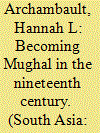

|
|
|
|
|
| Publication |
2013.
|
| Summary/Abstract |
In 1861, Nawab Sikandar Begum, the female ruler of Bhopal, toured Northern India for six months. The journey and its narration in the Taj al-iqbal (1873) were part of a broader project of princely self-fashioning aimed at both indigenous and British audiences. Taking the example of the Begums of Bhopal, this article engages with debates about travel and its relevance to the emergence of a nationalist imaginary, but also of its continuity with alternative visions in the latter half of the nineteenth century. The paper draws upon the insights of revisionist literature on princely states, which stress that princes at the mercy of British power nevertheless remained figures of indigenous authority, retaining a precarious autonomy in their territories. The Begums of Bhopal were able to turn their status as 'loyalists' towards consolidating a 'Mughal' aesthetic by recruiting artists, scholars and poets to underscore the state's autonomy.
|
|
|
|
|
|
|
|
|
|
|
|
|
|
|
|
| 2 |
ID:
126174
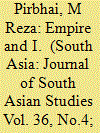

|
|
|
|
|
| Publication |
2013.
|
| Summary/Abstract |
Framed in a discussion of post-colonial approaches to the British Empire's influence on culture, a close reading of Captain Donald Campbell's late eighteenth-century travelogue contextualises the personal particularities in his assessments of Habsburg Europe, Ottoman West Asia and Mysorean/British South Asia. His is an imagination in which the bonds of 'religion' ameliorate the 'otherness' of continental Europeans, while his concept of 'enlightenment' learning is deployed to understand the Ottomans. Only in the case of South Asia is the very humanity of the 'other' denied. I argue that this landscape of otherness reflects the coincidence of the interests of his 'self' and the 'Empire', which overlap most thoroughly in South Asia. Campbell's travelogue is of value to post-colonial approaches, as it is a particularly poignant example of the manner in which the particularities of the 'self' contribute to the construction of broader cultural discourses permeated by 'Empire'.
|
|
|
|
|
|
|
|
|
|
|
|
|
|
|
|
| 3 |
ID:
126169


|
|
|
|
|
| Publication |
2013.
|
| Summary/Abstract |
Charting the rise and fall of the Grow More Food programme in India, this article explores a set of tensions that characterised development policies in the first decade after Independence in India. The post-colonial Indian state staked its legitimacy on securing economic independence for India, and, in particular, on being able to feed its citizens without resorting to importing food. The transition to food independence, however, was fraught and contested. In particular, this piece argues, the plans to get the nation to 'Grow More Food' as part of this drive towards national self-sufficiency were marked by a conflict between the dream of providing the benefits of development to all Indians and the reality that independent India's resources were extremely limited. In addition, this transition also involved a transformation in the nature of nationalism. The ruling Indian National Congress struggled to formulate a post-colonial nationalism because it was torn between using the state for development and urging the people to shape their own destiny outside of the state. It was also deeply ambivalent about rural citizens, who were viewed both as a burden and as a potentially limitless public resource. This article suggests that one of the defining features of post-colonial development was the tension between scientific and democratic development.
|
|
|
|
|
|
|
|
|
|
|
|
|
|
|
|
| 4 |
ID:
126173
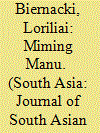

|
|
|
|
|
| Publication |
2013.
|
| Summary/Abstract |
This paper proposes an example of mimicry as an instance of intertextuality across genres, revealing a complex social response to normative, orthodox attitudes towards women through a close analysis of two very different types of male-authored religious texts from India, Tantric texts and a particularly famous law book, Manava Dharma Sastra. I argue that mimicry functions to undermine a normative stance towards women by appropriating and subverting the well-known verse from Manu's Law Book that states that women should not be permitted any independence from their male guardians. In this case, this verse is reformulated to reverse the meaning it originally had in Manu's Dharma Sastra, communicating a very different attitude towards women. This Tantric subversion of Manu suggests not only that elements of legal texts impacted on non-dominant populations through imitation and circulation in circles outside of expected Brahmanical orthodoxy, but also that textual satire via appropriation of these verses may have at times offered resistance, contesting the political assertions of a normative view.
|
|
|
|
|
|
|
|
|
|
|
|
|
|
|
|
| 5 |
ID:
126165


|
|
|
|
|
| Publication |
2013.
|
| Summary/Abstract |
This paper presents a women-centred study of the religious identities and practices of the diasporic Coorgs of Singapore through interviews and observances of their 'religious' practices, focusing on how these first-generation immigrants have created adaptive techniques of ancestor worship and the worship of Kaveriamma to perform their Coorg identity away from their ancestral homeland. Their spiritual practices in the home are contrasted with their engagements in broader Singaporean Hindu society, where issues of cultural identity and religious practice serve as a lens to comprehend how contemporary diasporic 'religiosities' among Coorg women (Kodavathees) are negotiated. The diasporic Kodavathees have found innovative ways to maintain their 'religious' practices and assert their distinct ethnic identity in Singapore, where being Hindu is often narrowly defined by broad social acceptance of the official ethnic taxonomies of the state.
|
|
|
|
|
|
|
|
|
|
|
|
|
|
|
|
| 6 |
ID:
126166


|
|
|
|
|
| Publication |
2013.
|
| Summary/Abstract |
In this article I consider the interface between state policy and popular culture by examining the issue of nuclear weapons in and around Indian popular cinema. Whilst it has been pointed out that there are no cinematic examples of nuclear annihilation in Indian film, I propose instead that the threat of it is nevertheless evident. Nuclear technology is deeply entangled in anxieties about the nation, its constituents such as the family, and its detractors such as forces to do with communalism and separatism. These disquieting dynamics do not enable a straightforward alliance between the nuclear and the national as official state discourse would have it, where nuclear weapons are advocated as a measure of India's military might in the contemporary era, or in other words, 'nuclear nationalism'. Rather than being nation-builders, films present nuclear weapons as dangerous nation-destroyers, for missiles harbour threats to people and civilisations especially in the hands of the figurative terrorist and those with designs against the nation of India. With this formulation there lies a latent critique of state policy, which nevertheless is imbued with patriotic rhetoric by the end of the film, when the hero averts disaster and/or invokes the state as the paragon of nuclear management.
|
|
|
|
|
|
|
|
|
|
|
|
|
|
|
|
| 7 |
ID:
126171
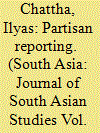

|
|
|
|
|
| Publication |
2013.
|
| Summary/Abstract |
This study analyses the press reporting in India and Pakistan of Partition-related violence in 1947 and the unsuccessful attempts by the colonial authorities to censor provocative accounts in a context of administrative collapse. Assessing the extent of bias exhibited by the coverage, the study highlights the respective roles of the press and of rumours in spreading 'news' of the violence and so contributing to its cycle. The focus is on the tactics of all the sides involved which were designed to attribute responsibility to a hostile 'other', while playing down each community's involvement in violence as merely defensive. The study presents a modest contribution to the wider notion of the role of 'blame displacement' in reporting violence and the inability of what might be termed the transitional colonial state to control the press amid a general decline in governance.
|
|
|
|
|
|
|
|
|
|
|
|
|
|
|
|
| 8 |
ID:
126163
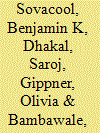

|
|
|
|
|
| Publication |
2013.
|
| Summary/Abstract |
Underinvestment, low levels of electricity access, natural disasters, topography and hydrology make Nepal's electricity crisis akin to 'peeling a pickle': difficult to pin down and hard to manage. Based primarily on the perceptions of a sample of experts, this article lays out a roadmap for how the 'pickle' of the Nepali electricity crisis can be peeled. Drawing on primary data collection from research interviews, the study offers a brief summary of the Nepali electricity and energy sectors. It then details six separate electricity challenges identified by respondents-topography and climate; political instability resulting from the aftermath of the Maoist insurgency; poverty and corruption; lack of financing and investment; constrained technological and human resources; and, finally, aid dependency and political manoeuvring. We conclude by calling on Nepali policymakers to invest in distributed generation, transmission upgrades, seasonal hydroelectric storage and industrial energy efficiency practices, and to introduce electricity tariff reforms, among other measures.
|
|
|
|
|
|
|
|
|
|
|
|
|
|
|
|
| 9 |
ID:
126172
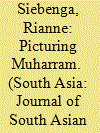

|
|
|
|
|
| Publication |
2013.
|
| Summary/Abstract |
The festival of Muharram had a central place in British colonial discourses on India as it was both a site of fascination and fear. While in textual discussions the fearsome aspect invariably came to the fore, in contemporaneous images of Muharram on magic lantern slides, on postcards or in film, fear was rarely depicted, although Muharram was never shown as being out of colonial control. Images tended to focus on Muharram as an attractive spectacle, with fear often located in the accompanying text. Between 1870 and 1915, the heyday of the Raj, visual economies in postcards and in film oversaw a transformation in representations of Muharram, in which the fear was displaced and the spectacle took centre stage, offering a fresh discourse around Muharram.
|
|
|
|
|
|
|
|
|
|
|
|
|
|
|
|
| 10 |
ID:
126170
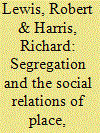

|
|
|
|
|
| Publication |
2013.
|
| Summary/Abstract |
For many, a defining feature of the colonial Indian city is the high rate of segregation of its European and Indians residents. Building on recent work that explores the messy realities of social and spatial relations, this paper argues that the social geographies of the colonial city were built on the social relations of place-the network of social relations that are bound up with a particular material setting. The result was that social spaces were centred on overlapping geographic patterns, intense negotiations over space, and heterogeneous lived-in spaces. In this paper, these points are examined through the case of Bombay's Modern Town at the turn of the twentieth century. Modern Town was supposedly the home of the city's European population and it stood in sharp contrast to the city's Native Town. However, Modern Town did not conform to the spatial topographies described by most writers. While formal residential segregation existed, social and economic articulation and interaction ensured that the district's social spaces were meshed in differentiated and complex ways.
|
|
|
|
|
|
|
|
|
|
|
|
|
|
|
|
| 11 |
ID:
126168
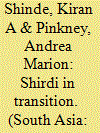

|
|
|
|
|
| Publication |
2013.
|
| Summary/Abstract |
The transformation of 'guru devotion' centres as pilgrimage destinations is a growing phenomenon in contemporary Indian religious practice. In this study, we consider how the town of Shirdi, in Maharashtra, is undergoing rapid transformation as it emerges as a religious tourism destination at the epicentre of the global Sai Baba movement. Since the 1918 death of Sai Baba, a Maharashtrian saint, Shirdi has grown from a rural hamlet to a bustling town with some thirty thousand permanent residents and an estimated annual influx of eight million short-term visitors. Focusing on Shirdi as a centre of guru devotion, we examine how socio-spatial transformations have created a new mosaic of regional pluralism at the site. While the coexistence of different communities is one of the hallmarks of religious pluralism in India, we argue that the complementary compartmentalisation of co-religionists hailing from different regions is a significant outcome of rapid urbanisation at pilgrimage sites, particularly those associated with guru devotion.
|
|
|
|
|
|
|
|
|
|
|
|
|
|
|
|
|
|
|
|
|